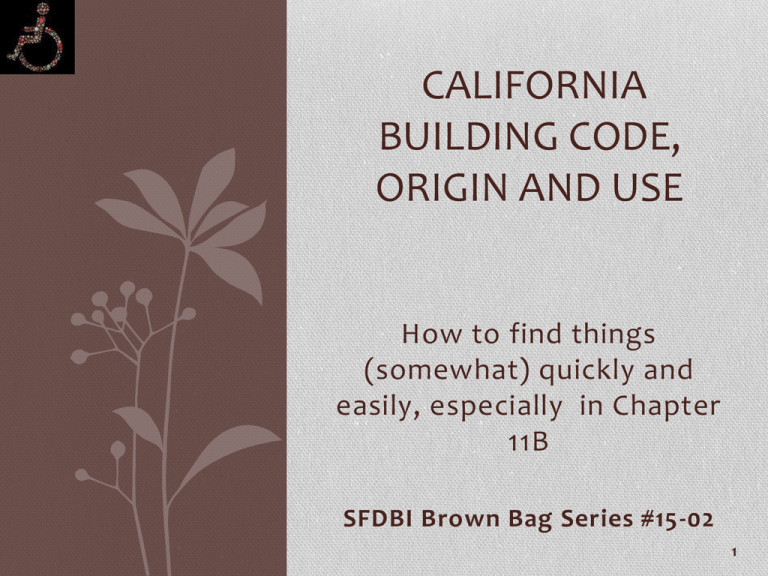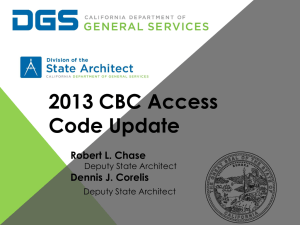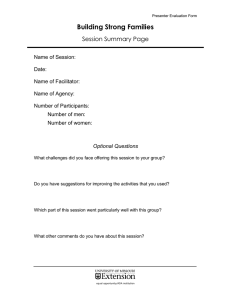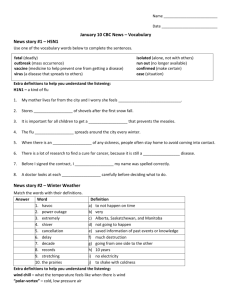How to use the California Building Code
advertisement

CALIFORNIA BUILDING CODE, ORIGIN AND USE How to find things (somewhat) quickly and easily, especially in Chapter 11B SFDBI Brown Bag Series #15-02 1 CALIFORNIA CODES Important California Legislation Regarding Access for Persons With Disabilities ACCESS TO BUILDINGS Health and Safety Code 19955 – 19959, 19952-19954 • Access to public accommodations (privately funded) • Access to public amusement and resorts Government Code 4450 -4461 and 4465 – 4470 • Access to public buildings and education (publically funded) Civil Code 51 and 54 – 55* • Unruh civil rights act, construction related access standards compliance CALIFORNIA FAIR HOUSING LAW Civil Code 51 – 53*, 54.1(b), 55.51 • Unruh civil rights act, prohibits discrimination in housing for persons with disabilities. • Disabled persons act. • Construction related accessibility Standards Compliance act. Government Code 12900 – 12996 • California fair employment and housing act *Enforced by Attorney General (law suits) not by Building Departments Authorizes: •Accessibility in Publicly Funded Buildings •DSA to Develop Code •DSA to obtain ADA Certification by 2010 (oops!) •DSA to grant unreasonable hardships •Enforcement by DSA, Local Jurisdiction •DSA to Amend the Code •The CASP Program HEALTH AND SAFETY CODE SECTIONS 19955-19959 Authorizes: •Accessibility for Privately Funded Buildings •Exceptions for Multistoried Buildings •Hardships if Equivalent Facilitation • Appeals Board (AAC) •Enforcement by Building Department •Civil Penalties for Violations THE UNRUH CIVIL RIGHTS ACT CIVIL CODE SECTIONS 51-52 •Persons with disabilities entitled to full and equal accommodations • Violation of ADA = Violation of California Law •Penalties Assessed •Enforced by State Attorney General TITLE 24 IS NOT THE ENERGY CODE! California Code of Regulations has 28 Titles – Title 24 is the California Building Standards California Code of Regulations Title 24 Has 12 parts. Part 7 is now part of Title 8 and title 2 has two parts, 2 & 2.5 (2.5 not adopted in San Francisco) Part1-2013 Administrative Code Part 2-2013 Building Code (Volume I and II) Part 2.5-2013 Residential Code Part 3-2013 Electrical Code Part 4-2013 Mechanical Code Part 5-2013 Plumbing Code Part 6-2013 Energy Code Part 7- No longer published in title 24 see title 8 CCR Part 8-2013 Historic Building Code Part 9-2013 Fire Code Part 10-2013 Existing Building Code Part 11-2013Green Building Standards Code Part 12-2013 Reference Standards Code 11 The California Code of Regulations (CCR) is a compilation of three types of building standards from three different sources: 1. Building standards that have been adopted by state agencies without change from building standards contained in national model codes. Written in plain text. –IBC and the 2010 ADA Standards for Accessible Design for chapter 11B. 2. Building standards that have been adopted and adapted from the national model codes to meet California conditions. Written in plain text and italics. 1. Building standards, authorized by the California Legislature, that constitute additions not covered by the model codes. Written completely in italics. 12 Model Code • 2012 International Building Code (IBC) State Code • 2013 California Building Code CALIFORNIA DOES NOT ADOPT CHAPTER 11 OF THE IBC. California has written and adopted it’s own accessibility standards in chapters 11*, 11A, 11B and 11C** (and parts of chapters 2,4,5,7,9,10,31 &34) since 1968. For the first time, California has adopted a model code for chapter 11B; the 2010 ADA Standards for Accessible Design.*** CA still writes 11A. *From UBC chapter 11, it was never enforced in California ** Eliminated in the 2013 code, it is now part of 11B *** Some of chapters 2,4,5,7,9,10,31 &34 are from IBC i.e. stairs , fire alarms etc. Chapter 11B Model Code • 2010 ADA Standards for Accessible Design State Code • 2013 California Building Code The California Building Code (CBC) is TITLE 24 Part 2 California Building Code Is adopted and published by the California Building Standards Commission on a Triennial Cycle Year one: Model Code Is Developed and Published 2012 IBC Year two: Model Code Is Amended and adopted (CA.) 2013 CBC Year Three: The code is published, local jurisdictions have 6 months to amend then it becomes law. 2013 CBC / 2013 SFBC There codes are modified on a 1.5 year cycle and corrected as needed 18 19 There are multiple agencies involved in the process. The handout includes a list of these agencies and what general areas they are involved with regarding the adoption and/or enforcement of the code. 20 The handout also includes a list of Building types and which of these regulate them. 21 The handout also includes a list of Building types and which of these regulate them. (cont.) 22 Every Chapter has a matrix which indicates which agencies have adopted which sections. 23 Chapter 11B is adopted only by DSA. IS THIS STUFF IMPORTANT? 24 Consider these definitions from CBC chapter 2. 25 Question CBC Section 11B-505.2 Where required. Handrail shall be provided on both sides of stairs. Definition of step is a riser and tread. Definition of Stairs is two or more steps. This does not have two or more risers. BASED UPON THE DEFINITIONS IN CHAPTER TWO IS A HANDRAIL REQUIRED AT THIS STAIR ? 26 IS A HANDRAIL REQUIRED AT THIS STAIR ? IT HAS ONLY ONE RISER. YES HUH? 27 LOOK AT THE MATRIX FOR CHAPTER 2 28 IS A HANDRAIL REQUIRED AT THIS STAIR ? IT HAS ONLY ONE RISER. YES! DSA-AC DID NOT ADOPT THE DEFINITION FOR “STAIRS” OR “STEPS” ONLY THE DEFINITION FOR “STAIR” (ONE OR MORE RISERS) AND STAIRWAY “ONE OR MORE FLIGHTS OF STAIRS” ALWAYS CHECK THE MATRIX !! 29 30 CALIFORNIA BUILDING CODE CBC now uses the 2010 ADA Standards For Accessible Design as the model code for 11B. 2013 CBC Chapter 11B Uses 2010 ADA Standards As Model Code (Similar to the use of the IBC for the rest of the code.) We do not enforce ADA (See Attorney General Letter) and California is still not deemed “Safe Harbor”-- but we’re getting close 32 CBC now uses the 2010 ADA Standards For Accessible Design as the model code for 11B. Because we Use the 2010 ADA Standards As Model Code we can seek guidance from • • • • U.S Access Board USDOJ Pacific ADA Center ADA.GOV 800 872-2253 800-514-0301 1-800-949-4232 http://www.ada.gov/ But only for those sections not in italics! For guidance on sections in Italics (California amendments) you must rely on DSA or Building Department. 33 FORMAT OF 11B 2013 CBC Division 1: Application and Administration.....….…........…...….....…......515 Division 2: Scoping Requirements..………........................................…...518 Division 3: Building Blocks..…............................................................…..546 Division 4: Accessible Routes..……..................................................…....552 Division 5: General Site and Building Elements..…................................572 Division 6: Plumbing Elements and Facilities..……................................579 Division 7: Communication Elements..…...........................................…..593 Division 8: Special Rooms, Spaces, and Elements ...........................….603 Division 9: Built-in Elements..………...................................................…..611 Division 10: Recreational Facilities..………..........................................…613 34 11B 2013 CBC is laid out the same as the 2010 ADA Standards 2010 ADA Standards Use “Chapters”; CBC Uses “Divisions” All the Definitions are now in Chapter 2 Almost all of the Scoping is in 11B Division 2 Division 3 contains general technical specifications (building blocks)-very important Divisions 4 through 10 specific technical data Without knowing the scoping in division 2 or knowing the Building Blocks in division three, the technical data will not make sense! 35 11B ICC did not include the changes to chapter 11B in the index. It still cites the 2010 CBC section numbers. This makes it very difficult to find things, but there are some short cuts you can take.. The format of 11B is identical to the 2010 ADA Guidelines for Accessible Design. It is also identical to the format of the ANSI A117.1 Standard Both of these can be used to find the appropriate code sections (with very few exceptions) The 2010 ADA can be downloaded for free from ADA.Gov website 36 11B The Division of the State Architect has published an Expanded Table of Contents as well as a Cross Reference Manual that cross references the 2010 code with the 2013. Both of these can be downloaded for free from the DSA website. 37 11B 2013 CBC Chapter 11B does not use occupancy classifications. The feds don’t have our occupancy groups. Chapter 11B differs from the rest of the building code in that it specifies different requirements based upon use. R occupancies are now found under “transient lodging guest rooms” and also under “Residential Facilities”. M occupancies will be found under “Sales and service”. I occupancies see “Medical care and long term care facilities” and also “detention and correctional facilities”. Also see: •Assembly areas (not just A occupancies) •Storage Facilities (New) •Judicial Facilities (New) •Amusement Rides •Golf Facilities •etc. 38 11B When looking for the requirements of any element: Always begin with Division 2. It is critical that you look up the scoping for the desired element, division 2 will send you to the specific technical data. For example: for washing machines and clothes dryers: consult 11B-214 for scoping and 11B-611 for technical specifications. Note: the DSA published an errata but is is very incomplete. Best to learn where things are. 39 11B Majority of exceptions to the code requirements are contained within Division 2. Other specific exceptions within the specific scoping areas of Division 2. NOTE: If you see an exception that states “reserved”; it is an exception in the ADA standards that California did not adopt 40 203 General Exceptions There are 14 general exceptions: 1. General 2. Construction sites 3. Raised areas 4. Limited access space 5. Machinery spaces 6. Single occupant structures 7. Detention and correctional facility 8. Residential facilities 9. Employee work areas 10. Raised refereeing and judging area 11. Water slides 12. Animal containment areas 13. Boxing or wrestling rings 14. Diving Boards / platforms CBC requires an accessible route to the ground floor entry point of #10 through #14; ADA does not. 41 2013 CBC Division 1: Application and Administration.....….…........…...….....…......515 Division 2: Scoping Requirements..………........................................…...518 Division 3: Building Blocks..…............................................................…..546 Division 4: Accessible Routes..……..................................................…....552 Division 5: General Site and Building Elements..…................................572 Division 6: Plumbing Elements and Facilities..……................................579 Division 7: Communication Elements ..…...........................................…..593 Division 8: Special Rooms, Spaces, and Elements ...........................….603 Division 9: Built-in Elements..………...................................................…..611 Division 10: Recreational Facilities..………..........................................…613 42 2013 CBC Division 1: Application and Administration.....….…........…...….....…......515 Division 2: Scoping Requirements..………........................................…...518 Division 3: Building Blocks..…............................................................…..546 Division 4: Accessible Routes..……..................................................…....552 Division 5: General Site and Building Elements..…................................572 Division 6: Plumbing Elements and Facilities..……................................579 Division 7: Communication Elements ..…...........................................…..593 Division 8: Special Rooms, Spaces, and Elements ...........................….603 Division 9: Built-in Elements..………...................................................…..611 Division 10: Recreational Facilities..………..........................................…613 43 2013 CBC Division 1: Application and Administration.....….…........…...….....…......515 Division 2: Scoping Requirements..………........................................…...518 Division 3: Building Blocks..…............................................................…..546 Division 4: Accessible Routes..……..................................................…....552 Division 5: General Site and Building Elements..…................................572 Division 6: Plumbing Elements and Facilities..……................................579 Division 7: Communication Elements ..…...........................................…..593 Division 8: Special Rooms, Spaces, and Elements ...........................….603 Division 9: Built-in Elements..………...................................................…..611 Division 10: Recreational Facilities..………..........................................…613 44 2013 CBC Division 1: Application and Administration.....….…........…...….....…......515 Division 2: Scoping Requirements..………........................................…...518 Division 3: Building Blocks..…............................................................…..546 Division 4: Accessible Routes..……..................................................…....552 Division 5: General Site and Building Elements..…................................572 Division 6: Plumbing Elements and Facilities..……................................579 Division 7: Communication Elements ..…...........................................…..593 Division 8: Special Rooms, Spaces, and Elements ...........................….603 Division 9: Built-in Elements..………...................................................…..611 Division 10: Recreational Facilities..………..........................................…613 45 2013 CBC Division 1: Application and Administration.....….…........…...….....…......515 Division 2: Scoping Requirements..………........................................…...518 Division 3: Building Blocks..…............................................................…..546 Division 4: Accessible Routes..……..................................................…....552 Division 5: General Site and Building Elements..…................................572 Division 6: Plumbing Elements and Facilities..……................................579 Division 7: Communication Elements ..…...........................................…..593 Division 8: Special Rooms, Spaces, and Elements ...........................….603 Division 9: Built-in Elements..………...................................................…..611 Division 10: Recreational Facilities..………..........................................…613 46 QUESTIONS? COMMENTS! 47 Thank You ! th Next Brown Bag May 7 BUILDING BLOCKS 48




